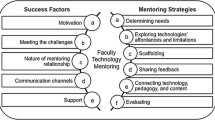Abstract
DATA from the educational technology development initiatives (technology grants and technology-immersion seminars) were used to map trends in the technology development of faculty at a large, research-one, public university. The study’s populations are described by gender, appointment status, and disciplinary area. Changes over a five-year period (1999–2003) in faculty baseline technology skills and interests are tracked; the success of programs in increasing faculty technology use are measured; and effects of institutional supports on the continued development of faculty competencies are discussed.
An analysis of data showed that faculty maintained consistent interest in and need for baseline skill development and that these instructional needs were well met by the technology immersion programs. The faculty-grant program demonstrated gradual progress in baseline skills from simple Web-based dissemination of course content to more interactive modalities. It supported best the “early adopter” faculty, whereas the immersion seminars served best the needs of novice users. Both programs resulted in successful educational technology implementations, however, all participants required ongoing support. Program successes substantiate continued support for educational technology instruction for faculty that accommodates faculty culture by providing broad-based and diverse models
Similar content being viewed by others
References
American Productivity and Quality Center & State Higher Educations Executive Officers. (1999).Today’s teaching and learning: Leveraging technology. Houston, TX: APQC.
Buckley, D.P. (2002). In pursuit of the learning paradigm.EDUCAUSE Review, 39(1), 29–38.
Chism, N. (2004). Using a framework to engage faculty in instructional technologies.EDUCAUSE Quarterly, 27(2), 39–45.
Crawford, G., Rudy, J.A., & The EDUCAUSE Current Issues Committee. (2003). Fourth annual EDUCAUSE survey identifies current IT issues.EDUCAUSE Quarterly, 26(2), 12–26.
EDUCAUSE.Information resources library: Faculty technology development. Retrieved February 21, 2005, from, http://www.educause.edu/SEARCH/606.
Epper, R., & Bates, A.W. (2001).Teaching faculty how to use technology: Best practices from leading institutions. Westport, CT: Oryx Press.
Frayer, D.A. (1999). Creating a campus culture to support a teaching and learning revolution.Cause/Effect, 22(2), 10–17.
Gillespie, K.H. (1998). The impact of technology on faculty development, life, and work.New directions in teaching and learning, 76 (Winter), 79–92. San Francisco, CA: Jossey-Bass Publishers.
Green, K.C. (2003).Campus computing 2003. Encino, CA: Campus Computing.
Green, K.C. (2004).Campus computing 2004. Encino, CA: Campus Computing.
Hagner, P.R. (2001, January 25). Interesting practices and best systems in faculty engagement and support.NLII White Paper. Retrieved July 9, 2004, from http://www.educause.edu/ir/library/pdf/NLI0017.pdf.
Hagner, P.R. (2000). Faculty engagement and support in the new learning environment.EDUCAUSE Review, 35(5), 26–37.
Kobulnicky, P., Rudy, J.A., & The EDUCAUSE Current Issues Committee. (2002). Third annual EDUCAUSE survey identifies current IT issues.EDUCAUSE Quarterly, 25(2), 8–21.
President’s Information Technology Advisory Committee (2001). PITAC Report 2001.Using information technology to transform the way we learn. Arlington, VA. Retrieved July 9, 2004, from http://www.hpcc.gov/pubs/pitac/pitac-tl-9feb01.pdf.
Rogers, E.M. (1995).Diffusion of Innovations. (4th ed.), New York: Free Press.
Spicer, D.Z., DeBlois, P.B. & The EDUCAUSE Current Issues Committee (2004). Fifth annual EDUCAUSE survey identifies current IT issues.EDUCAUSE Quarterly, 27(2), 8–22.
U.S. Department of Education, National Center for Education Statistics. (2001).The Condition of Education 2001: Indicator 48: Technology in postsecondary teaching. NCES 2001-072. Washington DC: U.S. Government Printing Office.
Author information
Authors and Affiliations
Additional information
ABOUT THE AUTHORCarole Ann Fabian is a member of the University Libraries faculty. Recent research, presentations, and publications have focused on the development of digital media libraries, faculty partnerships, innovations in scholarly communications, and technology-enhanced teaching methodologies. She has also served as University Libraries subject specialist for Art History, Architecture, and Theatre & Dance.
Rights and permissions
About this article
Cite this article
Fabian, C.A. A five-year analysis of university initiatives to increase faculty engagement. J. Comput. High. Educ. 17, 3–24 (2006). https://doi.org/10.1007/BF03032696
Issue Date:
DOI: https://doi.org/10.1007/BF03032696




